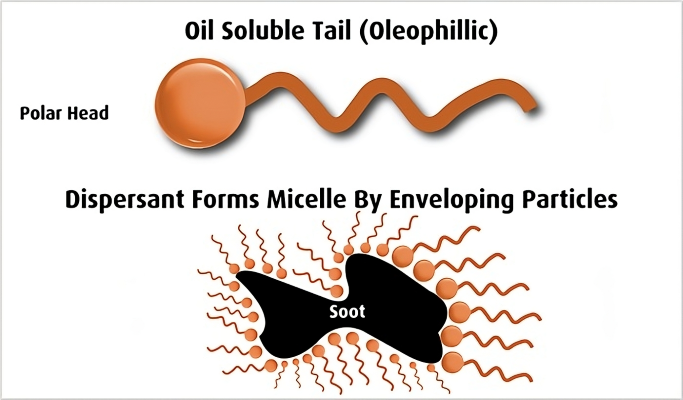By Steven Lumley, technical manager, WearCheck
As part of the ongoing discussion around different oil additives with condition monitoring specialist company, WearCheck, this time, the focus is on how dispersant additives function and why they make great crowd-controllers at social events.
| What are they? | Polymeric alkylthiophosphonates and alkylsuccinimides, organic complexes containing nitrogen compounds.
|
| What do they do? | Keep insoluble soot dispersed in the oil.
|
| How do they do it? | Insolubles are bonded by polar attraction to dispersant molecules, which prevents them from agglomerating.
|
Whenever I think of dispersant additives, an image of a night-club bouncer comes to mind. I know this might seem like a stretch of the imagination, but humour me. Among their many duties, night-club bouncers are also responsible for crowd control in their place of entertainment. Crowd control involves defusing potentially volatile situations by dispersing (keeping apart) club-going patrons who might otherwise want to “agglomerate” into a brawl.
Similarly, the function of a dispersant additive is to disperse undesirable elements like soot particles, that might otherwise want to agglomerate into larger particles.
In this respect, dispersant additives and night-club bouncers display a high degree of commonality – they discourage agglomeration through the process of dispersion.
Unlike night-club bouncers, however, our dispersant additive utilises some pretty nifty chemistry – so let’s take a look at how this additive controls crowds of soot particles in oil.
Dispersants are non-metallic, ashless cleaning agents that inhibit sludge-formation by keeping insoluble contaminants, like soot, dispersed in the oil and preventing them from coating metal surfaces. They are also mainly found in engine oils.
So, why all the fuss about soot particles agglomerating? Well, soot particles are sub-micron in size when formed, but with progressive fuel usage, large quantities of these particles are continually deposited in the oil, and will eventually agglomerate into larger particles which can cause all manner of evils.
Increasing concentration of soot contamination can cause sludge formation, higher operating temperatures, loss of anti-wear performance and increased viscosity. Added to this, the additional soot-loading increases the strain on the dispersant’s ability to function optimally.
With many engine manufacturers looking to extend oil-drain intervals, controlling soot agglomeration has become even more of an arduous task for this additive, as longer oil-drain intervals mean more soot-loading of the oil. If soot is not adequately dispersed by the engine oil, it can cause sludge to form on rocker and front engine covers, bearings to fail, valve bridges and fuel-injection links to wear, and filters to plug.
The durability of the oil and additive system in relation to the ability to disperse soot and maintain a regime of reduced wear, has led to significant changes in additive formulation in recent years and, as such, lubricant blenders have had to increase the treat rate of this additive. These days, dispersants are typically one of the major components of fully formulated engine oils, making up between 30 and 60 percent of the total additive package.
Now for the nifty chemistry part of how this additive works its magic – dispersant additives work by enveloping the soot particle in a single layer. The polar head of the dispersant molecule clings to the particle, directing the additive’s “oleophillic” tail outward to dissolve into the oil. This causes the soot particles to be suspended in the oil, prohibiting them from agglomerating with other soot particles or depositing onto component surfaces.
In the next instalment of the lube series, we introduce you to a whole new class of fascinating lubricant additives – bulk property chemical additives, starting with detergents.
Please visit or email marketing@wearcheck.co.za for more information.
Author bio:
Steven Lara-Lee Lumley is in charge of technical development and training for condition monitoring specialists WearCheck. She holds an N6 mechanical engineering diploma (HND N6) as well as Honeywell aerospace and ICML III accreditations.
Steven joined WearCheck in 2008 as a diagnostician and worked her way up to the position of senior diagnostician, during which time she diagnosed her millionth used-oil sample in addition to running oil analysis training courses for customers in several countries. In 2015, Steven was promoted to the position of technical manager.








